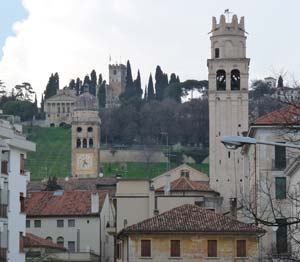About Conegliano
Conegliano is a cheerful and attractive historic town in wine-producing country close to the foothills of the Alps in the Veneto, northern Italy. The historic centre, on a hillside, is compact, and although the town has more recently sprawled over the plain below, it still retains a welcoming small-town feel. Conegliano (pronounced Conelyano) is a good stop on a tour of the Veneto, or a pleasant day out from nearby Treviso or Venice.
Find and book hotels in Conegliano. With location maps and guest reviews.
Visiting Conegliano
If you have looked at paintings by Cima da Conegliano during travels in northern Italy or even around the National Gallery, perhaps like me you have found your eyes sliding over the sweet Madonnas and enigmatic saints in the foreground and gazing instead at the artist’s careful and charming landscapes. There is usually a pastoral background, green slopes and a fortified town with towers rising up on a low hill. This town, or its inspiration, is frequently Conegliano, the hometown of the painter, whose full name was Giovanni Battista Cima, known as Cima da Conegliano, meaning ‘from Conegliano’. He lived (dates are approximate) from 1459 to 1517. Much of his working career was spent in Venice, and you can see his paintings in that city’s churches and in the Accademia Gallery, as well as other galleries around Italy and the rest of the world (including the National Gallery in London). The landscapes Cima painted so lovingly as backdrops to his commissioned religious works are almost all portrayals of the landscape of his native Veneto, and of Conegliano itself.
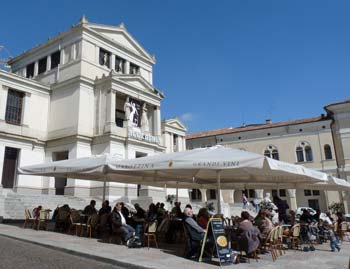
Conegliano is only 50 minutes from Venice on a cheap regional train, and the town’s railway station is excellently-placed for the historic centre. As you leave the station, Conegliano presents its attractions: a short car-filled avenue leads to a flight of steps climbing up to an arcade or loggia which leads through to a little piazzetta with a well. This small space acts as a kind of grand entrance onto the town’s theatrical main square, Piazza Cima. It’s literally theatrical: where you would expect to see the town’s cathedral or Duomo, Conegliano’s sloping piazza is dominated by a neo-classical theatre, guarded by sphinxes. This grand edifice, the Teatro Accademia, is flanked by the town hall, guarded in its turn by busts of Garibaldi and Vittorio Emanuele II. These nineteenth century monuments are the most modern touches in the old part of Conegliano, whose timeless feel is marred only by parked cars.
The principal street of the historic centre, Via XX Settembre, historically known as Contrada Grande, leads off in either direction from Piazza Cima: a really lovely procession of palaces and arcades. As you arrive in the historic centre, the tourist information office is just over the road. It has limited opening hours, like the town’s tourist attractions, so it’s a good idea to turn up in the morning, pick up some information and a map if you want one (not really necessary) and confirm opening hours, so you’re not caught out by 3-hour lunchtime closures.
Conegliano is a lovely little town. It’s not unknown to tourists – when I visited there were a few other visitors, all Italian, there to see a special Cima exhibition – but it has the ‘misfortune’ to be close to many other attractive and more significant towns, meaning that while tourists teem around Venice, and some explore Treviso, Conegliano maintains a mellow and peaceful atmosphere. Visitors can potter around the small centre, climb to the castle, and sit enjoying local Prosecco and food specialities, like Treviso radicchio, in a relaxed and unspoilt environment.
Tourist sights
Art-lovers on a Cima pilgrimage have two principal sights to see: the artist’s birthplace and the one painting he left in Conegliano. His altarpiece is the star feature of the town’s Duomo, an unusual building set behind a pointed-arch arcade. The façade is decorated with fading frescoes by the Flemish artist Lodewijk Toeput (known in Italy as Ludovico Pozzoserrato). The building is fairly plain inside, with a couple of attractive fifteenth-century frescoed columns and the Cima altarpiece, a Madonna and Child with saints and angels, hanging against rather shabby velvet curtains. There’s a more striking interior close by, which visitors should try to see despite its sometimes limited opening hours. This is the Sala dei Battuti, the ‘Hall of the Beaten’ in the Scuola dei Battuti, above the arches facing the street. The Battuti were a self-flagellating, charitable lay brotherhood which took up residence here in Conegliano. The present duomo started off as their church, only becoming the town’s cathedral in the seventeenth century (the former cathedral was uphill, by the castle). The ‘Sala dei Battuti’ is above the arches in front of the Duomo. It’s a long space covered in colourful, and rather charming, Biblical frescoes. mostly by Francesco da Milano. A secondary room displays Flemish tapestries which depict the story of David and Bathsheba.
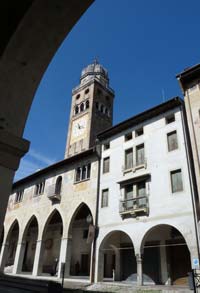
The Casa di Cima, Cima da Conegliano’s birthplace, is a short distance uphill; a pleasant building containing some period furnishings and reproductions of the artist’s finest works, along with minor archaeological finds which turned up during renovations. It’s not a major sight, but is still fairly interesting and the dwelling itself is enviably appealing.
An important part of a trip to Conegliano is a walk up to the castle on its hill. On the way, if they are open, you can take in three other little sights. The first is the Convento di San Francesco, a former monastery (now a college) with a pretty cloister which can be visited during opening hours. The second, part of the way up the Calle Madonna della Neve, a steep, ancient path climbing alongside the old defensive walls, is the Brolo di San Francesco, a pleasant little garden which belonged to the monastery. Next stop is the Chiesetta della Madonna della Neve, a tiny church with a rediscovered fresco halfway up the hill. Several of these sights have been restored and tended to by local voluntary organisations and their opening hours are restricted.
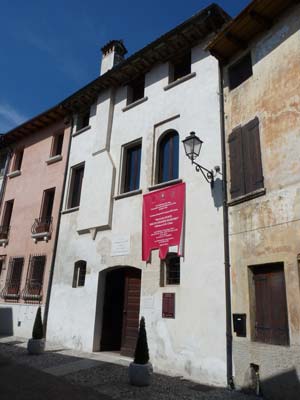
Conegliano’s castle, the Castello, doesn’t bristle with towers quite like Cima’s painted citadels. But there are still battlements and a couple of towers standing. A pleasant green garden fills the space inside the fortified walls. A cafe-restaurant is located in a tower, with outdoor tables which make a lovely spot to sit and relax with views over the green countryside rolling towards the Alps. The town museum is located in the principal tower complex, and it’s worth the price of admission just to climb up to the very top and survey the view in every direction. Inside you’ll find small historical displays (from ancient pottery to Toscanini’s marriage certificate) and an art collection.
At this point you’ve seen Conegliano’s main attractions. Before leaving, it is also worth walking the length of the long main street, Via XX Settembre, and admiring the Veneto architecture, with frescoed buildings, elegant palaces, and the practical arcaded walkways – cool in summer, sheltered in winter. Among the palaces is Palazzo Sarcinelli, an elegant sixteenth-century frescoed palace used for art exhibitions. Along the street and around Piazza Cima you’ll find a few bars and restaurants where you can enjoy a glass of local Prosecco or a meal. There are also antique and clothes shops, a picturesque greengrocers and an excellent pasticceria, although there are more modern shops and cafes down in the new town a few yards away.
A little way from the centre of town is a historic Jewish cemetery. Conegliano once had a synagogue, which was transported to Jerusalem. The town also has a small museum dedicated to the Alpini, Italy’s Alpine troops.
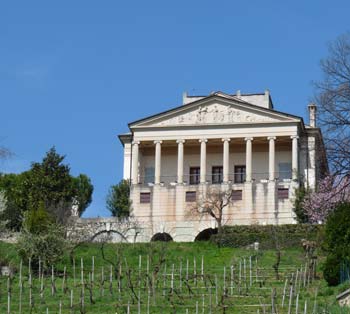
Events
Conegliano has an annual folklore event, the Dama Castellana, which involves re-enactments, a human game of draughts and colourful Renaissance costumes. This takes place in June, while in spring the town hosts a flower show, ‘Conegliano in Fiore’. When I visited I was lucky enough to see an unheralded Saturday afternoon show by the town’s sbandieratori – flag-throwers – who perform in traditional costume, accompanied by drummers, with truly impressive panache and timing (which you can watch on Youtube).
Travel to Conegliano
By train: Conegliano is connected by cheap regional trains to Treviso and Venice (50 minutes away); these trains are frequent enough for easy day trips, but do check timetables as there are gaps. The railway line continues to Udine. From Conegliano railway station you can reach the historic centre in five minutes by walking straight ahead and up the large flight of steps to Piazza Cima.
By bus: Conegliano is served by buses operated by La Marca (see links panel for timetables), with services to Vittorio Veneto, Oderzo, Montebelluna, Valdobbiadene and other local towns. Tourists aren’t likely to be interested in the outlying parts of Conegliano, which are connected with urban buses run by ATM.
By air: The most convenient airport for Conegliano is Treviso Airport, served by Ryanair (as ‘Venice Treviso’). Venice Marco Polo Airport is also nearby.
Things to do around Conegliano
Treviso is very close to Conegliana and one can be used as a base for exploring the other. If you liked the castle and folklore of Conegliano, another town with a similar atmosphere is Marostica, where there’s a big re-enactment and human chess event every other year. For an art pilgrimage, take a trip to Castelfranco Veneto, the walled hometown of Giorgione, who left a painting in the town’s Duomo. If you have a car, you could follow the ‘Strada del Prosecco’, a tour of the local wine country.
Conegliano accommodation
Conegliano has some appealing hotels right in the centre of town. While it’s not an obvious place to spend more than one day, it would make an interesting base, and has access to other Veneto attractions by road and rail. If you want to be in the historic heart, you can’t do better than the Hotel Canon d’Oro, which is on Via XX Settembre in a frescoed 15th-century building.
Useful external links
Tamburi & Sbandieratori Conegliano (in Italian)
Cima da Conegliano at the National Gallery, London
Veneto destinations
- Veneto region
- Abano Terme
- Asolo
- Bassano del Grappa
- Brenta Canal
- Caorle
- Castelfranco Veneto
- Chioggia
- Cittadella
- Concordia Sagittaria
- Conegliano
- Cortina d’Ampezzo
- Lido di Jesolo
- Malcesine
- Marostica
- Monselice
- Montegrotto Terme
- Padua
- Portogruaro
- Rovigo
- Sottomarina
- Treviso
- Venetian Lagoon
- Venice
- Verona
- Vicenza
- Veneto art & architecture itinerary
- Veneto villas – Vicenza: La Rotonda & Villa Valmarana ai Nani
- Veneto villas – Villa Pisani & Villa Foscarini Rossi, Strà
- Venice Airport
- Treviso Airport
